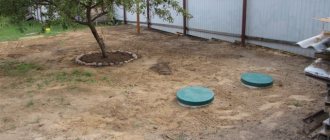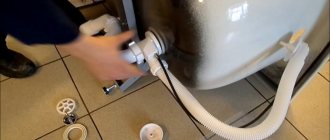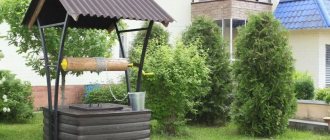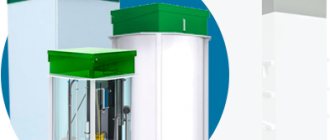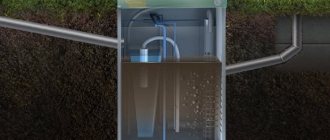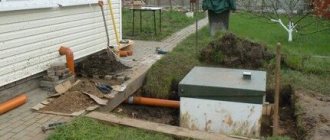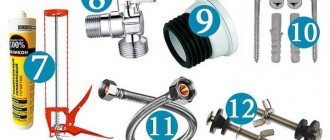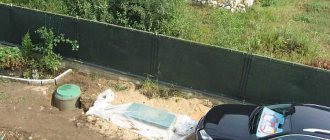Filtration field or dispersion well
After a three-section septic tank, water enters a drainage pipe laid in crushed stone of fraction 20-40 with a slope of 1%. Be sure to lay a blind red 1-2 meter pipe between the drainage and the exit. The size of the drainage area greatly depends on the type of soil, available area, daily flow rate, and type of residence in the house. And of course, it depends on financial capabilities and desires. The bigger, the better. For example, if a house is being built for one family and permanent residence on former agricultural gardens (that is, loam with a probability of up to 99%), if possible, make the site at least 15 square meters (so as not to return to this issue in the future). Very often it is suggested to install a filtration well, unfortunately this can only be done in sand and loam, since its effectiveness on clay is not at all justified.
Minimum length and width of drainage trenches depending on daily discharge in meters:
- ST-1 0.5x6;
- ST-1.5 0.5x7;
- ST-2 0.5x9;
- ST-3 0.5x10;
- ST-4 0.5x14;
- ST-5 0.5x18.
Installation of rings under a reinforced concrete septic tank
The user's septic tank is a classic and well-developed scheme of concrete rings combined into two wells connected by overflows.
The first well has a sealed bottom, the second is a filter well, without a bottom, will be perforated and sprinkled with crushed stone.
This septic tank scheme “works” only when the groundwater level is low and the soil has good absorption capacity. With a high groundwater level, the second well will soon be flooded with groundwater with all the ensuing negative consequences.
This article describes how to make a surface septic tank from Eurocubes at a high groundwater level. According to the user, at first he wanted to buy “GOST” concrete rings. After searching, I found the following suggestions:
- concrete ring with a diameter of 1500 mm - 3840 rubles;
- concrete ring with a diameter of 700 mm - 1580 rubles;
- transition cover from a ring with a diameter of 150 cm to a ring with a diameter of 70 cm - 3800 rubles;
- bottom for a concrete ring – 5300 rub.
The last amount (the bottom for the first sealed well) did not fit into the planned budget at all. Having asked the manufacturer why the bottom is so expensive, the user found out that the bottom for a ring with a diameter of 1500 mm has a diameter of 2000 mm. Hence the high price.
PavelTLT
At first I wanted to fill the bottom of the first well with self-mixed concrete, but I decided to look for more. As a result, I found “non-GOST” rings and a bottom that suited me, which are made by local small manufacturers, at an affordable price and of good quality. In the end I bought:
- bottom with a diameter of 1800 mm - 1 pc. — 2400 rub.;
- ring with a diameter of 1500 mm, a height of 900 mm – 2 pcs. — 3100 rub.;
- ring with a diameter of 1500 mm, a height of 600 mm – 2 pcs. — 2500 rub.;
- cover “15” with a hole for a ring with a diameter of 700 mm – 2 pcs. — 2400 rub.;
- ring with a diameter of 700 mm, a height of 600 mm – 4 pcs. — 1250 rub.;
- polymer-sand hatch – 2 pcs. — 1250 rub.
Delivery of the rings by truck with a manipulator and their installation cost 3 thousand rubles.
When installing the rings of the first well, the joints were coated with cement-sand mortar, and fragments of flat stones were inserted between the rings of the second (filtration) well (for drainage).
The picture below shows that the depth of the pit and the trench are the same, and the top of the ring protrudes by the planned amount.
The user left the installation of the hatches “for later.”
To check the wells, PavelTLT, using “12” fittings, welded a 3 m long ladder along which you can go down to inspect the system.
The next stage is the completion of the filtration well and the final hydraulic check of the assembled sewer system.
Standards for SNT and individual housing construction sites
First of all, it is worth understanding the abbreviations and their meanings. construction - individual housing construction. The land on which the individual housing construction is located is located within the boundaries of a populated area and has the right to be provided by the authorities with the necessary set of infrastructure. SNT is a gardening non-profit partnership. This is an association of several plots for conducting agricultural activities. Plots can only be located outside populated areas.
Permanent residence in individual housing construction and seasonal stay in SNT require different regulations from SNiP and SanPiN. Currently, installation standards do not depend on ownership status, but on the permanent or temporary type of residence and the number of people.
Important! A septic tank can only be installed on private property. Placing a structure behind a fence is considered illegal.
Ventilation system
During the fermentation of waste, gases are released:
- methane;
- hydrogen sulfide;
- phosphorus compounds;
- a number of other carcinogenic substances.
They are removed from the septic tank using ventilation: a choke is installed in the last chamber. Thus, air enters the sewer through the drain pipe (part of the riser leading to the roof), passes through the septic tank and is removed through the air vent in a natural way.
If biological wastewater treatment using aerobic bacteria is used (superior to anaerobic bacteria in performance), the ventilation system is equipped with a forced supply of fresh air. This issue is solved by installing a compressor.
Installing the container
We lower the fiberglass septic tank onto the pre-leveled bottom. If there is water in the hole, then fill it starting from the middle section, periodically throwing the hose over the service necks in order to avoid distortion. Fiberglass partitions are load-bearing, so they will not fall when one chamber is filled to the top.
The liquid begins to flow into adjacent chambers only when it reaches the overflow. Therefore, it is necessary to fill evenly for leveling, like a boat in a lake.
Weighting the container
Despite the requirements of SNiP, it is not necessary to buy or pour a concrete slab under the container. The septic tank itself is full all the time, which means it only comes to the surface when pumped out by a sewage disposal machine. There are several methods to prevent floating:
- bury the septic tank with excavated earth mixed with sand, which will result in a sticking effect (after all, it is when using only bulk materials, in conditions of high groundwater, that the force of Archimedes becomes maximum);
- fill it completely with soil, but it is better not to do this if you want to get a long service life of more than 10 years;
- concrete the top of the barrel (for example, a two-cube septic tank requires 800-1000 kg of mixture).
Price of septic tanks for a private house and design requirements
The domestic market offers a wide range of treatment structures, among which there are many budget septic tanks for summer cottages without pumping.
The calculation of the cleaning structure is carried out taking into account the principles of multi-stage cleaning. The purification process can be carried out using 3 or 2 chambers.
Table of ratings and prices of popular designs:
| Name | Cleaning efficiency, % | Salvo discharge, l | Cost, rub. |
| Topas 8 | 98 | 440 | 106900 |
| Eco-Grand 5 | 98 | 250 | 73600 |
| Unilos Astra 3 | 98 | 150 | 66300 |
| Triton | 98 | 500 | 48000 |
| Rostock | 90 | 250 | 26800 |
| Tank 1 | 70 | 600 | 34900 |
| Termite | 70 | 400 | 73720 |
In some cases, conditions make it possible to create a single-chamber treatment facility with a capacity of 20-30 m³, which will be more effective than a three-chamber septic tank.
Diagram of a three-chamber septic tank with aeration
Purpose of cameras:
- the first is intended for the accumulation and subsequent separation of wastewater into fractions;
- the second – performs the function of purification (here the process of decay and removal of organic matter occurs);
- the third is used for final filtration and removal of liquid into the ground.
With the exception of the drainage tank, all chambers must be sealed.
Local deep wastewater treatment stations
This is the most effective and progressive equipment for autonomous sewer systems. In multi-chamber devices, organic contaminants are removed as a result of the activity of aerobic and anaerobic bacteria, exposure to chemical reagents or certain physical processes (for example, ultraviolet irradiation or the phenomenon of cavitation).
The degree of purification of such stations ranges from 96 to 100%; technically pure water can be used for household needs or directly returned to natural circulation.
Other advantages of such equipment include: · high productivity; · no need to use special sewer equipment to clean the chambers; · unpretentiousness in maintenance.
The main disadvantages are: · energy dependence - the systems use aerators, dispensers and other devices that require power supply; · the need to create some specific conditions for compliance with technologies, for example, ensuring temperature conditions in severe winters and a constant supply of nutrient medium for the life of bacterial colonies or regular replenishment of chemicals; · high purchase price
In general, such installations best meet all the requirements for modern treatment facilities.
